
| What is Flavor and Fortune? |
| How do I subscribe? |
| How do I get past issues? |
| How do I advertise? |
| How do I contact the editor? |
Read 12930925 times
Connect me to:
| Home |
| Articles |
| Book reviews |
| Letters to the Editor |
| Newmans News and Notes |
| Recipes |
| Restaurant reviews |
| Article Index (all years, slow) |
| List of Article Years |
| Article Index (2025) |
| Article Index (last 2 years) |
| Things others say |
| Related Links |
| Log In... |
| Authors |
| Categories & Topics |
TOPICS: Asian American Restaurant Association; Mellie's Dumplings; More on Mangosteen; India's First Chinese Community
| by Jacqueline M. Newman |
Newman's News and Notes
Summer Volume: 2008 Issue: 15(2) page(s): 29 and 30
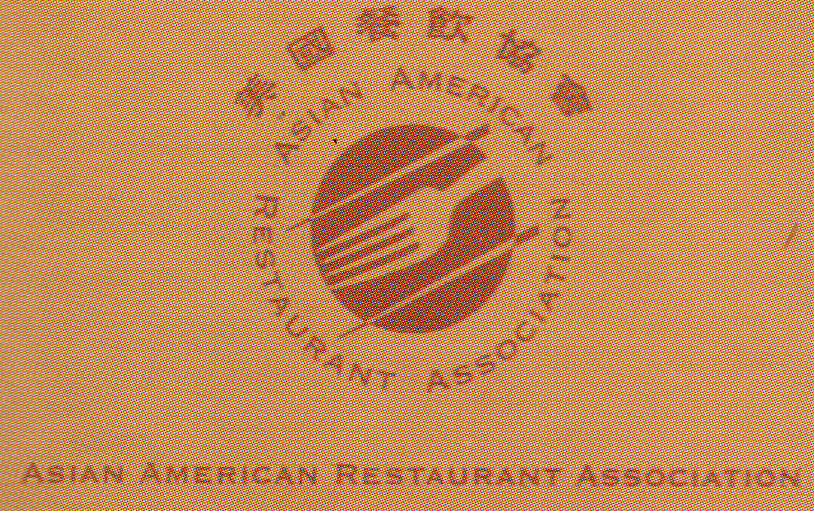
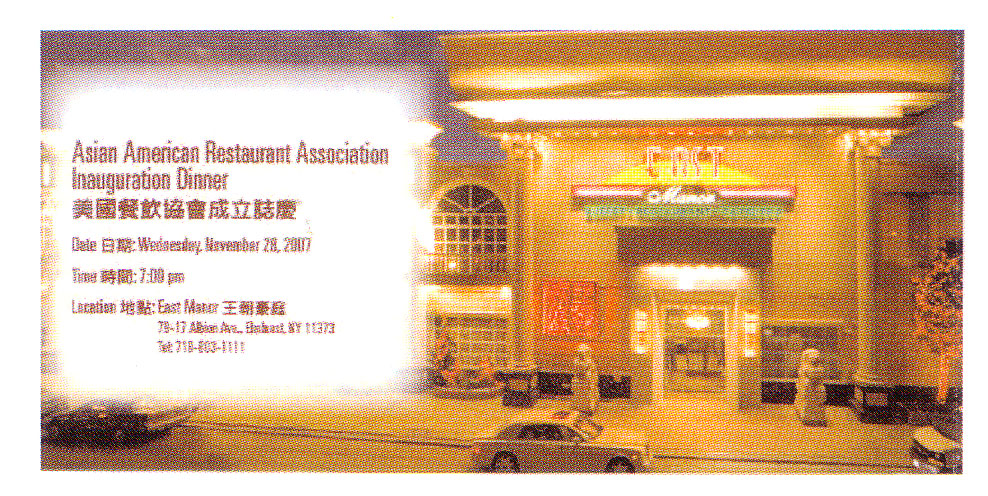 The ASIAN AMERICAN RESTAURANT ASSOCIATION, their card is to the left, made their debut with a bang-up inaugural banquet November 28th at an East restaurant. More than two thousand folk were in attendance. With proclamations from dozens of politicos, Chinese traditional lion dancers who outdid themselves, acrobats who were spell-binding, jugglers who kept everyone mesmerized, and many 'plain Joe's, ourselves included, there was much to enjoy. All this as the result of a year of hard work that made this association happen, their first beautiful gathering glow.
The ASIAN AMERICAN RESTAURANT ASSOCIATION, their card is to the left, made their debut with a bang-up inaugural banquet November 28th at an East restaurant. More than two thousand folk were in attendance. With proclamations from dozens of politicos, Chinese traditional lion dancers who outdid themselves, acrobats who were spell-binding, jugglers who kept everyone mesmerized, and many 'plain Joe's, ourselves included, there was much to enjoy. All this as the result of a year of hard work that made this association happen, their first beautiful gathering glow.
With lofty goals, the mission was briefly verbalized by the co-presidents to: promote, develop, innovate, succeed...(and) advance generations of Asian American cooking and traditions. Henceforth known as AARA, the group has well thought-out bylaws and is a non-profit non-political professional advocate organization intending to support researchers and practitioners of the culinary arts, nutritionists, and others nationwide who promote Chinese food culture in America.
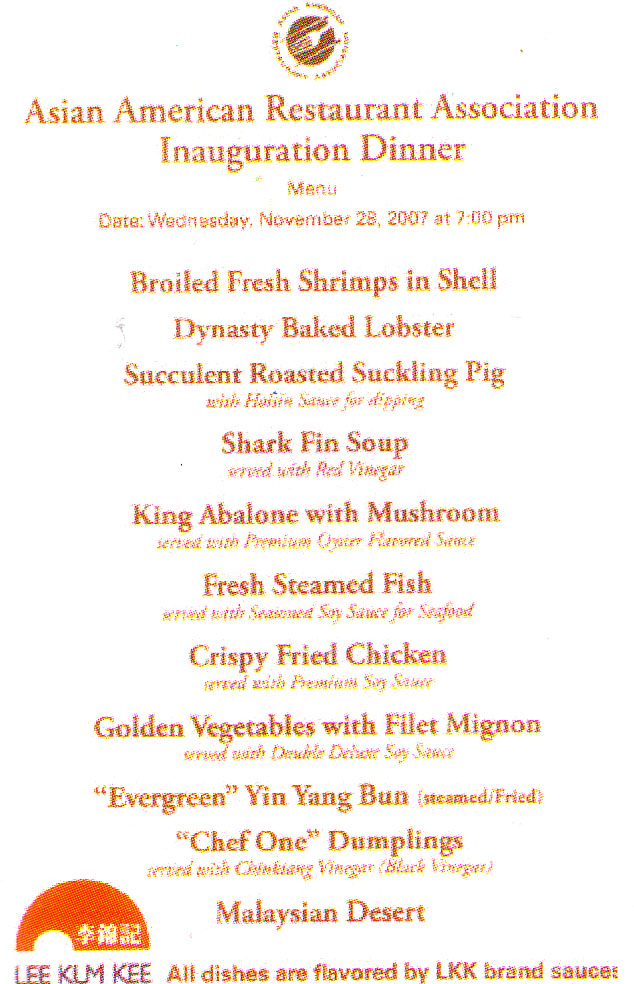 The headquarters is in New York City, on the second floor at 3 Ludlow Street, with membership open to companies and individuals in the food industry. We promptly sent in a check for dues and offered support to the co-presidents: Cheun Ping Hui and Kwai Hing Tang, the two honorary presidents: William Su and Qi Fu Wen, the dozen Vice Presidents including Peter How, who kept after us to be sure we would attend. We look forward to working with them and all the other officers and folks behind the scenes who worked tirelessly to get this association started.
The headquarters is in New York City, on the second floor at 3 Ludlow Street, with membership open to companies and individuals in the food industry. We promptly sent in a check for dues and offered support to the co-presidents: Cheun Ping Hui and Kwai Hing Tang, the two honorary presidents: William Su and Qi Fu Wen, the dozen Vice Presidents including Peter How, who kept after us to be sure we would attend. We look forward to working with them and all the other officers and folks behind the scenes who worked tirelessly to get this association started.
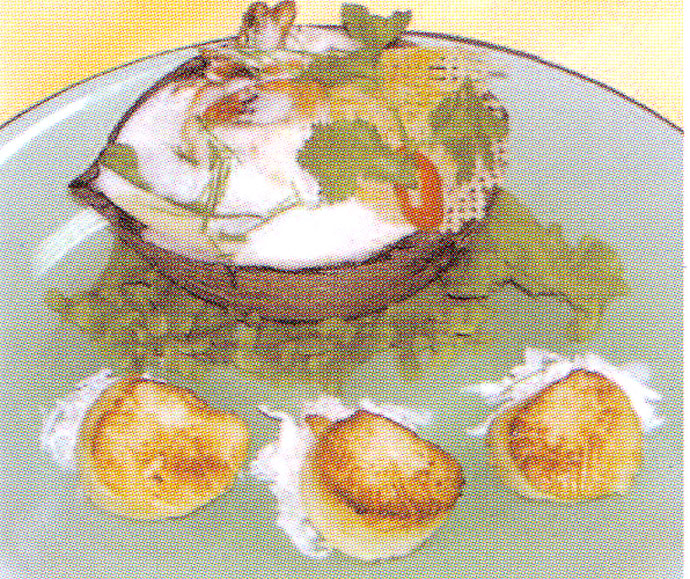 The menu at its Inauguration Dinner is pictured as is a dish from their inaugural book. The menu says dishes are flavored by Lee Kum Kee sauces, one of their many sponsors. This was the very best big banquet we ever attended, every dish delicious, beautiful, too. Service was amazing, too, and everyone's plate was changed for every course. The folk in the kitchen at East Manor, 79-17 Albion Avenue, Elmhurst (in Queens) NY 11373 outdid themselves. Their picture can be seen on the raffle ticket next to the association's business card, and win we did not.
The menu at its Inauguration Dinner is pictured as is a dish from their inaugural book. The menu says dishes are flavored by Lee Kum Kee sauces, one of their many sponsors. This was the very best big banquet we ever attended, every dish delicious, beautiful, too. Service was amazing, too, and everyone's plate was changed for every course. The folk in the kitchen at East Manor, 79-17 Albion Avenue, Elmhurst (in Queens) NY 11373 outdid themselves. Their picture can be seen on the raffle ticket next to the association's business card, and win we did not.
Those in attendance left satiated with fantastic food, beer and beverages. We enjoyed our first Chivas with green tea (a sponsor); it won't be our last. Everyone left with bottles of soy sauce from the above-mentioned sponsor, calendars, key rings, packets of tea (from Good Tea & Water at 332 Grand Street in Manhattan) and many other goodies. In addition, they left with warm wishes from this great group of organizers.
We promised and will work with them to see their lofty goals fulfilled; suggest you do, too. You can e-mail them at info@aara-us.com and check their website which is: www.aara-us.com or you can call them at (212) 965-8882 for more information. Feel free to ask about the gorgeous event book, a page with Chef How's recipe is illustrated with this article. Some bought it or a crystal memento and other things featured there and available at their headquarters.
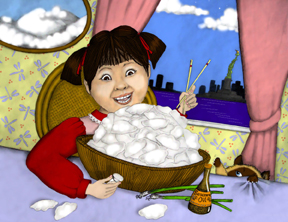 MEILING'S DUMPLINGS is the title of the book that won second place in the National Children's Book Competition. It was the only entry about Chinese food among the finalists; and we offer congratulations to Jenny Sheih, the author who is now seeking a publisher.
MEILING'S DUMPLINGS is the title of the book that won second place in the National Children's Book Competition. It was the only entry about Chinese food among the finalists; and we offer congratulations to Jenny Sheih, the author who is now seeking a publisher.
The book begins with "Mommy, who's that tall lady holding the torch over there?" Meiling is pointing towards the water from the bedroom window of her new home in New York City. It ends with "Just then, Meiling didn't feel so different any more. She was just like the other children, but with her own special ingredients.
Between these pages are commentary about Meiling's dumpling lunch. She wants them and not a turkey or a peanut butter and jelly sandwich. Her mother reluctantly agrees and Meiling gets to watch and help her make them. Before leaving for school, she also gets a last look at Lady Liberty. At her new school, she eats lunch alone without a sandwich that all other children have.
It is Meiling's ability to show and tell that her dumplings are like the sandwiches they are eating, but with special ingredients, that wins her respect and friends. As she shares her culinary heritage, she tells a tale of how and why her food really is the same, dough on the outside and meat within. What a wonderful culinary roadmap to friendship.
Congratulations to Jenny Shieh for showing a culinary bridge closing a cultural divide. Kudos to Lisa J. Michaels whose illustrations enhance this winning book whose cover we share above.
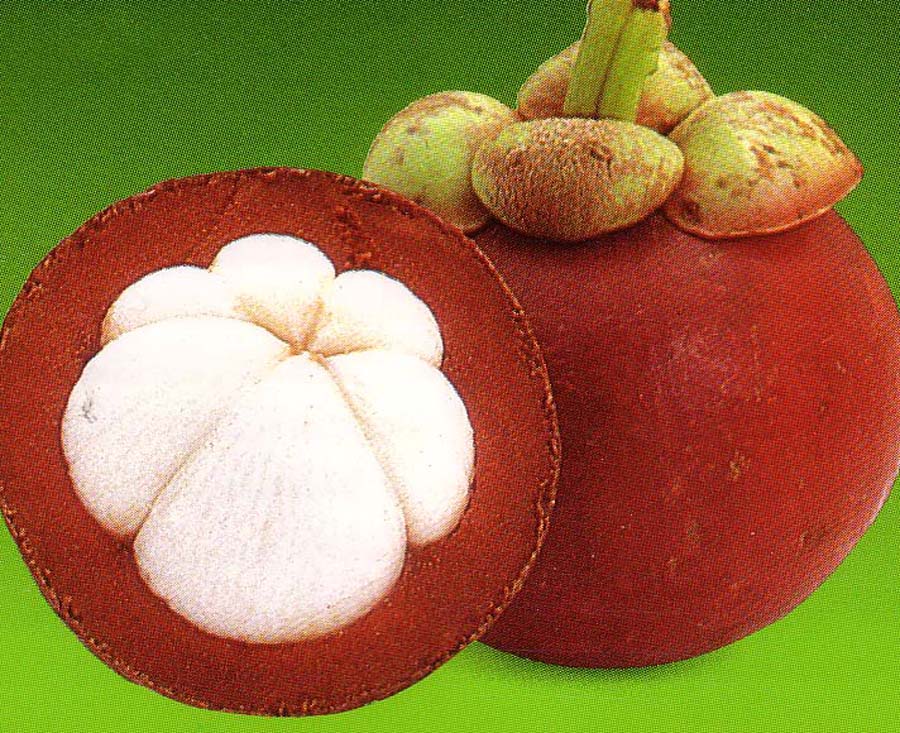 MORE ON MANGOSTEEN: The Queens of Fruits, written about in Volume 12 (2) on pages 9-10, and 32 tells a lot about this Malaysian fruit, now a part of China's repertory. Captain James Cook, in 1770, introduced it to Sri Lanka (then called Ceylon), and from there it spread to many countries in Southeast Asia including China
MORE ON MANGOSTEEN: The Queens of Fruits, written about in Volume 12 (2) on pages 9-10, and 32 tells a lot about this Malaysian fruit, now a part of China's repertory. Captain James Cook, in 1770, introduced it to Sri Lanka (then called Ceylon), and from there it spread to many countries in Southeast Asia including China
Readers wrote to ask how to open this fruit. Do so with the stem up using a sharp knife. Cut all around, an eighth of an inch deep through the husk-like shell. Using gentle pressure, twist the top one way, the bottom the other, and discard the top half of the husk-like shell. Gently remove the segments from the bottom half being careful not to squeeze or distort their shape. One can remove the segments or leave them there for consumers to remove their own. Enjoy mangosteens raw and use their segments in cooking, but be aware that up to three of them can have a pit within their five, seven, or sometimes nine white sections
Mangosteen, called yang luo han in Chinese, can now be imported into the United States. We have not seen any of its wild relatives such as shan ji zi, or the South-China mangosteen called huang ya. There is a rare variety called 'egg tree' native to Southeast Asia; it is cultivated in Taiwan. But we have not seen that one either; it is called dan shu.
Years ago, some eighty percent of Chinese and other Asian fruits were gathered in the wild. This is no longer true; China now has many fruit orchards that they call 'gardens', including some for mangosteens. The African Mangosteen, botanically known as Garcinia livingstonei, bears orange not white fruit. It and all mangosteens have seeds that are dried and chewed as a stimulant. This slow-growing tree-bearing fruit is commonly found canned; we have never seen it frozen.
Traditional medical practitioners say to eat mangosteen to maintain intestinal health and strengthen the immune system. They also say it is known as 'Imported Buddha Disciple Fruit, Phoenix Fruit, and Yellow Teeth Fruit,' but that these relatives are technically berries and not mangosteens.
INDIA'S FIRST CHINESE COMMUNITY should be credited to Yang Tai Chow who first landed on the banks of the Hooghly River in 1778. He started a sugar mill with other Chinese who jumped ship. There are no traces of that mill. One can find records of more modern Chinese migrations to India such as one in 1820 when a small Chinese population came to Calcutta from Fujian and Giangzhou (then called Fukien and Canton, respectively). They erected a temple dedicated to Guab Yu, a historical figure of the Three Kingdoms Period circa the mid-900's CE.
Many Chinese immigrants became tanners. They worked at the six hundred and fifty tanneries near where they landed before these businesses were moved from the area. They produced custom-made shoes, including ones for most of the world's polo teams.
There is virtually no information about early Chinese restaurants there, perhaps due to attrition. Many Chinese who worked in them or at the tanneries left for America and Canada, traveling via Taiwan. They took their distinctive Indian-Chinese food to these countries, and more recently to others. There are many rebuilt Chinese restaurants in these areas of India now and thousands of others elsewhere in that country.
Americans call a noodle dish chao main, and have since about 1903. This dish has been a staple in Chinese-Indian homes lots longer as has a chili chicken dish. While not authentically as Chinese as is America's Chop suey, Professor E.N. Anderson points out in Food if China, that this dish is native to Toisan (and there called tsap suei and called tsa sui in Mandarin). The miscellaneous scraps in this dish are leftover vegetables stir-fried with noodles, bean sprouts added later in the cooking. There may be other Chinese-Indian influences in this dish, but we have never referenced any.

Copyright © 1994-2025 by ISACC, all rights reserved
Address
3 Jefferson Ferry Drive
S. Setauket NY 11720